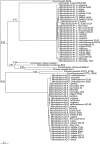Ancient trans-specific polymorphism at pheromone receptor genes in basidiomycetes
- PMID: 19001292
- PMCID: PMC2621169
- DOI: 10.1534/genetics.108.093708
Ancient trans-specific polymorphism at pheromone receptor genes in basidiomycetes
Abstract
In the majority of sexual organisms, reproduction occurs almost exclusively through the combination of distinct and alternate forms, called sexes or mating types. In some fungi, there can be dozens to hundreds of alternate alleles that determine compatible mating types. Such extensive polymorphism is expected to be maintained by balancing selection, and in extreme cases may give rise to trans-specific polymorphism. Here, we analyzed sequences of two pheromone receptors in the Microbotryum fungal species complex (Basidiomycota), which has only two alternate mating types. Several lines of evidence strongly suggest that the pheromone receptors are two allelic sequences acting to determine the alternate A1 and A2 mating types required for mating in Microbotryum. Phylogenetic trees of pheromone receptors in the Microbotryum species complex indicated a trans-specific polymorphism: the Microbotryum sequences from a given mating type were all more similar to the pheromone receptors of distantly related classes of fungi than to the alternate pheromone receptor in the Microbotryum species. A phylogenetic tree built using other known pheromone receptors from basidiomycetes showed that trans-specific polymorphism is widespread. The pheromone receptor alleles from Microbotryum appeared as the oldest, being at least 370 million years old. This represents the oldest known trans-specific polymorphism known in any organism so far, which may be due to the existence of sex chromosomes, obligate sexuality, mitochondrial inheritance linked to the mating type, and a highly selfing mating system in Microbotryum.
Figures




Similar articles
-
Fungal Sex: The Basidiomycota.Microbiol Spectr. 2017 Jun;5(3):10.1128/microbiolspec.funk-0046-2016. doi: 10.1128/microbiolspec.FUNK-0046-2016. Microbiol Spectr. 2017. PMID: 28597825 Free PMC article. Review.
-
Using phylogenies of pheromone receptor genes in the Microbotryum violaceum species complex to investigate possible speciation by hybridization.Mycologia. 2010 May-Jun;102(3):689-96. doi: 10.3852/09-192. Mycologia. 2010. PMID: 20524600
-
Linkage to the mating-type locus across the genus Microbotryum: insights into nonrecombining chromosomes.Evolution. 2012 Nov;66(11):3519-33. doi: 10.1111/j.1558-5646.2012.01703.x. Epub 2012 Jun 26. Evolution. 2012. PMID: 23106715
-
Evidence for maintenance of sex determinants but not of sexual stages in red yeasts, a group of early diverged basidiomycetes.BMC Evol Biol. 2011 Aug 31;11:249. doi: 10.1186/1471-2148-11-249. BMC Evol Biol. 2011. PMID: 21880139 Free PMC article.
-
Basidiomycete mating type genes and pheromone signaling.Eukaryot Cell. 2010 Jun;9(6):847-59. doi: 10.1128/EC.00319-09. Epub 2010 Feb 26. Eukaryot Cell. 2010. PMID: 20190072 Free PMC article. Review.
Cited by
-
Genome biology and evolution of mating-type loci in four cereal rust fungi.PLoS Genet. 2024 Mar 18;20(3):e1011207. doi: 10.1371/journal.pgen.1011207. eCollection 2024 Mar. PLoS Genet. 2024. PMID: 38498573 Free PMC article.
-
Fungal Sex: The Basidiomycota.Microbiol Spectr. 2017 Jun;5(3):10.1128/microbiolspec.funk-0046-2016. doi: 10.1128/microbiolspec.FUNK-0046-2016. Microbiol Spectr. 2017. PMID: 28597825 Free PMC article. Review.
-
Obligate sexual reproduction of a homothallic fungus closely related to the Cryptococcus pathogenic species complex.Elife. 2022 Jun 17;11:e79114. doi: 10.7554/eLife.79114. Elife. 2022. PMID: 35713948 Free PMC article.
-
Evolutionary strata in a small mating-type-specific region of the smut fungus Microbotryum violaceum.Genetics. 2009 Aug;182(4):1391-6. doi: 10.1534/genetics.109.103192. Epub 2009 May 17. Genetics. 2009. PMID: 19448270 Free PMC article.
-
Ontogenetic Variation in Macrocyclic and Hemicyclic Poplar Rust Fungi.Int J Mol Sci. 2022 Oct 27;23(21):13062. doi: 10.3390/ijms232113062. Int J Mol Sci. 2022. PMID: 36361849 Free PMC article.
References
-
- Aguileta, G., S. Marthey, H. Chiapello, M. H. Lebrun, F. Rodolphe et al., 2008. Assessing the performance of single-copy genes for recovering robust phylogenies. Syst. Biol. 57 613–627. - PubMed
-
- Anisimova, M., J. P. Bielawski and Z. H. Yang, 2001. Accuracy and power of the likelihood ratio test in detecting adaptive molecular evolution. Mol. Biol. Evol. 18 1585–1592. - PubMed
-
- Barr, C., M. Neiman and D. Taylor, 2005. Inheritance and recombination of mitochondrial genomes in plants, fungi and animals. New Phytol. 168 39–50. - PubMed
Publication types
MeSH terms
Substances
LinkOut - more resources
Full Text Sources

